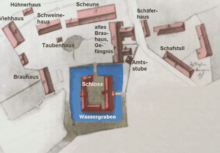Fallersleben Castle
Schloss Fallersleben in Wolfsburg district Fallersleben is next to the castle Neuhaus and Wolfsburg Castle one of the most important historic buildings in the city of Wolfsburg. It is located on the castle pond and, together with the Michaeliskirche and the old brewery, forms a historical ensemble.
Building history
The castle was built between 1520 and 1551 after the forerunner system was destroyed during the Hildesheim collegiate feud (1518–23). The complex originally had a U-shaped arrangement with a courtyard opening to the south. Until 1760, the castle was surrounded by a moat about 12 m wide and 5 m deep. Access was only possible via two bridges. A bridge and a piece of trench have been reconstructed based on archaeological excavations from 1998. Before that, the character of a moated castle at that time was barely recognizable after the moats had been filled in. Of the three previous wings, only the west wing with the stair tower in the inner courtyard is still preserved today. It is a half-timbered building about 40 m long on a stone foundation. The Kavaliershaus also exists .
In the earlier castle buildings there were 16 living rooms (court parlor, bedroom, chamber, maiden parlor) as well as rooms for civil servants, economic staff and the armory and silver room of the ducal seat. The palace complex included numerous outbuildings, such as the old brewery , and extensive land that was later converted into a ducal domain . In the years 2001–03, Fallersleben Castle was renovated in accordance with a listed building.
history

Both Schloss Fallersleben and Schloss Gifhorn were built by Duke Franz von Braunschweig and Lüneburg (1508–1549), who died during the construction work at the age of 41. He had ruled the Duchy of Gifhorn , to which Fallersleben also belonged, from Gifhorn since 1539 and had introduced the Reformation in the region . His wife was Klara von Sachsen-Lauenburg , daughter of Duke Magnus I of Sachsen-Lauenburg . She received after the death of Duke Francis the castle as a dower house and completed the construction in 1551. She lived more than 27 years Fallersleben and caused an upsurge in patch Fallersleben (Coinage 1555 regime in 1573, brewing regulations, etc.). She died in 1576 while visiting Barth and was buried there. After her death, a Drost (administrator) sat on the castle. Renovations were already carried out by Duke Christian in 1616, by Duke August in 1636 and by Duke Friedrich in 1649. The ducal residence was given up in the middle of the 17th century and the main building of the castle was transformed into an official residence, which from 1855 housed state authorities (tax office, district court, town hall).
today
Since 1991 the castle building on the ground floor has housed the Hoffmann-von-Fallersleben-Museum , a museum on the history of German poetry and democracy in the 19th century. It depicts the life of the poet of the Deutschlandlied and the story of his children's songs. On the upper floor there is a painting gallery with pictures of Franz Hoffmann-Fallersleben ( Hoffmann von Fallersleben's only child ). The wood carvings and stucco ceilings are also worth seeing. A number of rooms can now be rented for events in Fallersleben Castle. It is also used as a registry office.
In the years 2001–2003 archaeological investigations were carried out on the castle grounds. Basement rooms with 1.3 m thick walls and barrel vaults were exposed. Since the excavations, the cellar and foundation walls have been roofed over with glass and can be viewed by visitors. In the past, the cellars under the castle were connected to one another and served as storage rooms for food.
literature
- Hans Adolf Schultz : Castles and Palaces of the Braunschweiger Land , Braunschweig 1980, Fallersleben Castle , pp. 12-13, ISBN 3-87884-012-8
- Hans Adolf Schultz: Castles, palaces and mansions in the Gifhorn-Wolfsburg area. Gifhorn 1985
- Ernst Andreas Friedrich : The Fallersleben Castle. Pp. 63-65. In: If stones could talk. Volume III, Landbuch-Verlag, Hanover 1995, ISBN 3-7842-0515-1 .
Web links
- Entry by Christian Frey and Stefan Eismann on Fallersleben Castle in the scientific database " EBIDAT " of the European Castle Institute
- Castle in the Lower Saxony Monument Atlas
- Description and photos at burgerbe-Blog.de
- School project on the history of the castle
- Photos of the castle
- Description at Braunschweigische Landschaft
- Description at wolfsburg.de
- Historical photo of Fallersleben Castle at the Photo Archive Photo Marburg
Individual evidence
- ↑ Clara von Braunschweig-Lüneburg, b. 1518 in Lauenburg, died 1576. in Barth. stadt-barth.de, accessed on September 26, 2019.
Coordinates: 52 ° 25 ′ 1.5 ″ N , 10 ° 42 ′ 59.4 ″ E




